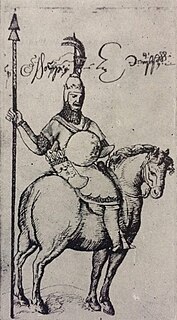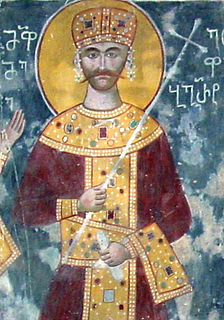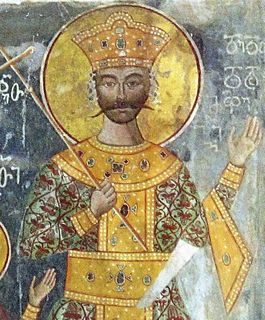
Mamia III Gurieli, also known as Mamia the Great Gurieli or the Black Gurieli, of the western Georgian House of Gurieli, was Prince of Guria from 1689 to 1714. Involved in civil wars plaguing western Georgia, he became King of Imereti three times in the years of 1701, 1711–1712, and 1713–1714. After his first reign as king for a year in 1701, he abdicated the throne of Imereti, being unable to tolerate the influence of his father-in-law Giorgi Abashidze. Subsequent periods of his royal career was the result of a feud with Giorgi VII of Imereti. Mamia died while still sitting on the throne of Imereti, which then reverted to his rival Giorgi VII.
Giorgi IV Gurieli, of the House of Gurieli, was Prince of Guria from 1711 to 1726, and a king of Imereti in western Georgia in 1716. He was installed as regent of Guria by his father, Mamia III Gurieli, then the king of Imereti, in 1712. In 1716, he seized the crown of Imereti, but was forced to abandon the enterprise later that year. Returning to Guria, his rule was challenged by a faction of local nobility, which included his mother Elene and brother Kaikhosro III Gurieli. He was finally able to crush the opposition after making peace with Bezhan Dadiani, Prince of Mingrelia.
Mamia I Dadiani was a member of the House of Dadiani and eristavi ("duke") of Odishi in western Georgia from 1323 until his death.
Giorgi II Dadiani was a member of the House of Dadiani and eristavi ("duke") of Odishi in western Georgia from 1345 until his death.
Mamia II Dadiani was a member of the House of Dadiani and eristavi ("duke") of Odishi, latter-day Mingrelia, in western Georgia from 1396 until his death.
Liparit I Dadiani was a member of the House of Dadiani and eristavi ("duke") of Odishi, latter-day Mingrelia, in western Georgia from 1414 until his death. Under his rule, Mingrelia became largely independent from the disintegrating Kingdom of Georgia in the 1460s.
Shamadavle Dadiani was a member of the House of Dadiani and eristavi ("duke") of Odishi (Mingrelia) in western Georgia from 1470 until his death. He succeeded his father Liparit I Dadiani and continued his predecessors' efforts to garner more autonomy as the united Kingdom of Georgia was approaching to its end.
Vameq II Dadiani was a member of the House of Dadiani and eristavi ("duke") of Odishi (Mingrelia) in western Georgia from 1474 until his death.
Giorgi III Dadiani was Prince of Mingrelia, of the House of Dadiani, from 1572 to 1573 and again from 1578 until his death. He was a son and successor of Levan I Dadiani.
Mamia IV Dadiani was Prince of Mingrelia, of the House of Dadiani, from 1573 to 1578 and again from 1582 until his death. He was a younger son of Levan I Dadiani.
Liparit III Dadiani was Prince of Mingrelia, of the House of Dadiani, from 1657 until being deposed in 1658.

Vameq III Dadiani was Prince of Mingrelia, of the House of Dadiani, from 1658 until being deposed in 1661. He was also briefly King of Imereti in 1661. He assumed both Mingrelian and Imeretian thrones and lost them during a messy civil war in western Georgian polities and was killed by assassins while hiding in a refuge of the mountains of Svaneti.

Giorgi IV Dadiani was Prince of Mingrelia from 1691 to 1704 and from 1710 to 1715. Giorgi's accession to rulership, following his ouster of the First House of Dadiani, inaugurated Mingrelia's second Dadiani dynasty, stemming from the Chikovani clan. Giorgi was also known as Lipartiani (ლიპარტიანი) by virtue of having Salipartiano as a fief from 1682 to 1715. Giorgi was actively involved in a series of civil wars that plagued the western Georgian polities. He was eventually deposed by his own son and placed under house arrest.
Mamia I Gurieli, of the House of Gurieli, was Prince of Guria from 1512 until his death in 1534. Succeeding on the death of his father Giorgi I Gurieli, Mamia became involved in the conflict between the two eastern Georgian kingdoms of Kartli and Kakheti in 1520; by force of arms, he compelled David X of Kartli to agree on peace with Levan of Kakheti, his son-in-law. Mamia Gurieli's 1533 campaign, jointly with his namesake Prince of Mingrelia, against the homebase of Circassian pirates ended in a fiasco, with Mamia being captured and ransomed later that year.
Giorgi II Gurieli, of the House of Gurieli, was Prince of Guria from 1564 to 1583 and again from 1587 to 1600. Succeeding on the death of his father Rostom Gurieli, Giorgi's rule over his small principality, located in southwest Georgia, was a period of conflict with the neighboring Dadiani of Mingrelia and increasing assertiveness of the Ottomans whom Gurieli submitted in 1581. His reign was interrupted, from 1583 to 1587, by a Mingrelian invasion, but Giorgi was able to resume the throne with Ottoman support.
Mamia II Gurieli, of the House of Gurieli, was Prince of Guria from 1600 until his death at the hands of his own son Simon in 1625. Mamia's rule over his small principality, located in southwest Georgia, saw efforts to rebuff encroachments of the Ottoman Empire, with which he was forced to make peace in 1614, conceding the loss of territories and placing Guria under the obligation of paying tribute.
Mamia IV Gurieli, of the western Georgian House of Gurieli, was Prince of Guria from 1726 to 1756 and again from 1758 to 1765 and from 1771 to 1776. Intermissions of his rule was the result of Mamia's rivalry with his younger brother, Giorgi V Gurieli, and complex political situation in the region, including the Ottoman encroachments and efforts by the kings of Imereti to bring western Georgian polities under their supreme authority.
Invasion of Jiketi the remarkable event of Grand-duke of Odishi, Mamia III Dadiani (c.1512-1533), which resulted by defeat of allied forces, in 31 January 1533.













